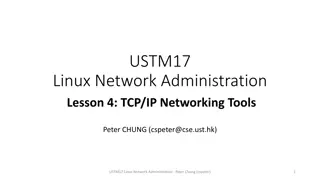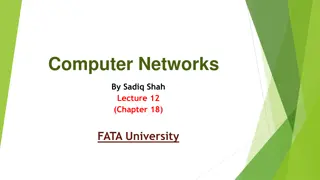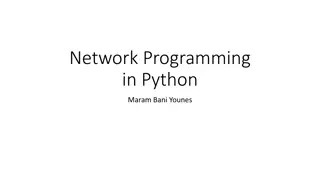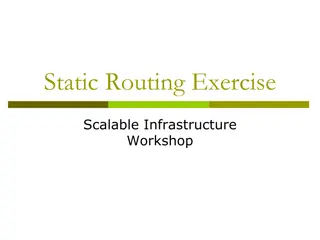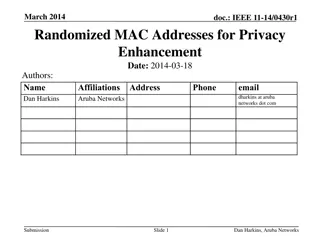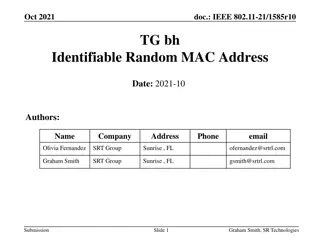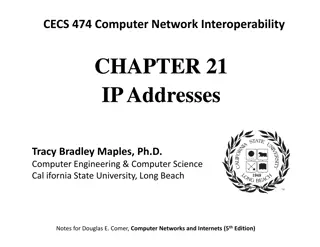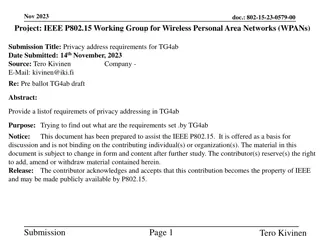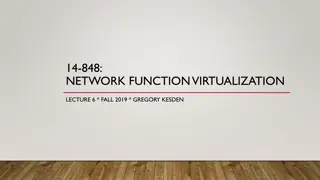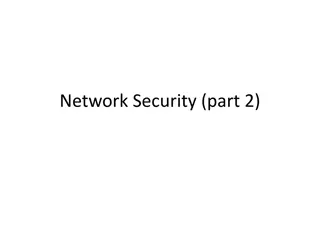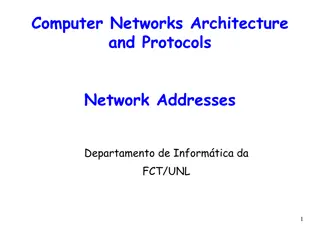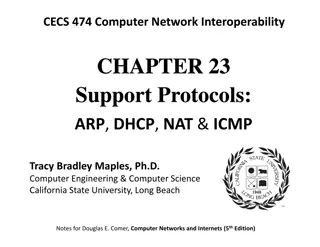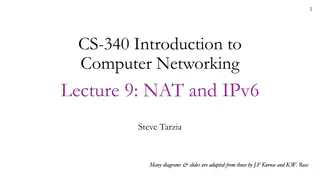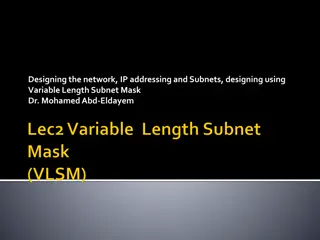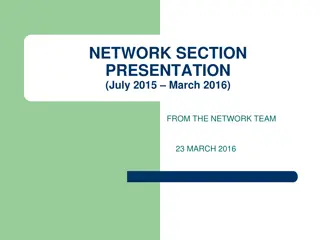Apache MINA: High-performance Network Applications Framework
Apache MINA is a robust framework for building high-performance network applications. With features like non-blocking I/O, event-driven architecture, and enhanced scalability, MINA provides a reliable platform for developing multipurpose infrastructure and networked applications. Its strengths lie i
3 views • 13 slides
Modeling and Generation of Realistic Network Activity Using Non-Negative Matrix Factorization
The GHOST project focuses on the challenges of modeling, analyzing, and generating patterns of network activity. By utilizing Non-Negative Matrix Factorization (NMF), realistic network activity patterns can be created and injected into live wireless networks. Understanding and predicting user behavi
4 views • 28 slides
Automated Anomaly Detection Tool for Network Performance Optimization
Anomaly Detection Tool (ADT) aims to automate the detection of network degradation in a mobile communications network, reducing the time and effort required significantly. By utilizing statistical and machine learning models, ADT can generate anomaly reports efficiently across a large circle network
8 views • 7 slides
Understanding TCP/IP Networking Tools in Linux Administration
The iproute2 software suite in Linux provides utilities for network control and monitoring, replacing legacy tools like ifconfig, netstat, route, and arp. This lesson delves into displaying information about network interfaces, network addresses (IP addresses), routing tables, assigned DNS servers,
2 views • 22 slides
Revolutionizing Network Management with Intent-Based Networking
Explore the concept and benefits of Intent-Based Networking (IBN) in simplifying network configuration and enhancing efficiency. Learn how IBN automates network operations, aligns with business objectives, improves security, and ensures scalability and reliability. Discover the potential of IBN tool
0 views • 14 slides
Understanding Bluetooth Low Energy Addresses in IEEE 802.11-21/1535r0
The document explores the features of resolvable addresses in Bluetooth Low Energy (BLE) within the IEEE 802.11-21/1535r0 standard. It discusses the two types of addresses in BLE, Public and Random, and their usage. The emphasis is on Random addresses due to their popularity and privacy features. Th
2 views • 11 slides
Network Compression Techniques: Overview and Practical Issues
Various network compression techniques such as network pruning, knowledge distillation, and parameter quantization are discussed in this content. The importance of pruning redundant weights and neurons in over-parameterized networks is highlighted. Practical issues like weight pruning and neuron pru
0 views • 37 slides
Network Slicing with OAI 5G CN Workshop Overview
Overview of Network Slicing with OAI 5G CN workshop focusing on the crucial role of network slicing in realizing the service-oriented 5G vision. This workshop covers topics like multiple logical networks creation on shared infrastructure, different types of network slices, preparation and instantiat
1 views • 6 slides
Understanding IPv4 Addresses and Classful Addressing in Computer Networks
Explore the basics of IPv4 addresses, address space, hierarchy in addressing, and classful addressing in computer networks. Learn about the unique 32-bit structure of IPv4 addresses, address space calculation, notation methods, and the hierarchical nature of network addressing. Dive into the concept
2 views • 14 slides
Network Design Challenges and Solutions in Business Data Communications
Issues in designing a Local Area Network (LAN) include needs analysis, technological design, and cost assessment. The traditional approach involves structured systems analysis, but faces challenges due to rapidly changing technology and increasing network traffic. The Building Blocks Approach recomm
1 views • 20 slides
Understanding 5G RAN Network Slicing and Architecture
Explore the intricate world of 5G Radio Access Network (RAN) and Network Slicing, delving into concepts such as SO Service Orchestrator, SDN-C Service Design, and Core Network Elements. Discover the significance of managing and designing mobile slice services, including eMBB, Massive IoT, and Missio
0 views • 26 slides
Understanding Snort: An Open-Source Network Intrusion Detection System
Snort is an open-source Network Intrusion Detection System (NIDS) developed by Cisco, capable of analyzing network packets to identify suspicious activities. It can function as a packet sniffer, packet logger, or a full-fledged intrusion prevention system. By monitoring and matching network activity
0 views • 23 slides
Understanding Network Programming in Python
Learn about IP addresses, ports, network sockets, and socket functions in network programming using Python. Explore the concepts of communication endpoints, socket creation, and essential functions for network communication.
1 views • 34 slides
Data Flows and Network Challenges in Particle Physics Infrastructure
This overview delves into the data flows and network challenges faced in particle physics infrastructure, focusing on the JUNO project. It discusses the process of data reception, storage, and replication across various data centers, highlighting the bidirectional nature of data flows. Additionally,
0 views • 24 slides
Progress of Network Architecture Work in FG IMT-2020
In the Network Architecture Group led by Namseok Ko, significant progress has been made in defining the IMT-2020 architecture. The work has involved gap analysis, draft recommendations, and setting framework and requirements. Phase 1 focused on identifying 19 architectural gaps, such as demands for
1 views • 11 slides
Understanding Static Routing in Network Infrastructure Workshops
Explore the concepts of static routing in networking workshops, covering Unix and Cisco network interface configurations, static routes, default routes, and advantages and disadvantages of static routing. Learn about IP routing configuration, assignment of IPv4 addresses, and FreeBSD network interfa
4 views • 37 slides
Understanding Interconnection Networks Topology
Exploring the topology of interconnection networks helps determine the arrangement of channels and nodes, impacting network cost, performance, latency, energy consumption, and complexity of implementation. Abstract metrics such as degree, hop count, and network diameter play crucial roles in evaluat
1 views • 56 slides
Enhancing Privacy with Randomized MAC Addresses in 802.11 Networks
This presentation discusses the use of randomized MAC addresses as a privacy-enhancing measure in 802.11 networks. Passive observation of MAC addresses poses privacy risks, and the proposal suggests assigning random MAC addresses to portable devices to mitigate tracking risks. By periodically changi
0 views • 10 slides
Transportation Network Modeling and Analysis with C.Coupled SE Platform
This content outlines the features and functionalities of the C.Coupled SE Platform (CSET Platform) developed by the Connetics Transportation Group. It covers aspects such as interface design, inputs merging, purposes, platform development using Cube, TAZs merging, and network attributes. The platfo
0 views • 11 slides
Meridian: An SDN Platform for Cloud Network Services
Meridian is an SDN platform developed by Mohammad Banikazemi, David Olshefski, Anees Shaikh, John Tracey, and GuohuiWang at IBM T. J. Watson Research Center. The platform focuses on providing cloud network services efficiently. It encompasses an architecture that enables faster and more convenient n
0 views • 21 slides
Proposal for Establishing Epochs in IEEE 802.11-17/2059r1 Network
This proposal by Stephen Rodriguez from Cisco suggests partitioning time into epochs based on network trust levels to determine when clients should change their MAC addresses dynamically. The idea involves rotating MAC addresses at specified intervals depending on the trust level of the network conn
0 views • 5 slides
IEEE 802.11-21/1585r10: Identifiable Random MAC Address Presentation Summary
This presentation discusses the concept of Identifiable Random MAC (IRM) addresses in the IEEE 802.11-21/1585r10 standard. It covers the purpose of IRM addresses in preventing third-party tracking while allowing trusted parties to identify specific devices. The presentation outlines the use of Ident
0 views • 24 slides
IEEE 802.1CQ: Address Assignment and Validation Protocols
This document explores the assignment and validation of unicast addresses within IEEE 802 networks, emphasizing the need for uniqueness to prevent operational errors and security breaches. It discusses the challenges of ensuring globally-unique addresses, proposing the implementation of a single val
0 views • 6 slides
Understanding IP Addressing in Computer Networks
IP addressing provides a seamless network for users by abstracting and providing a uniform addressing scheme used by higher-layer protocols and applications. IP addresses identify connections rather than specific computers, with IPv4 using 32-bit integers and IPv6 using 128-bit addresses. The divisi
0 views • 19 slides
Understanding Network Analysis: Whole Networks vs. Ego Networks
Explore the differences between Whole Networks and Ego Networks in social network analysis. Whole Networks provide comprehensive information about all nodes and links, enabling the computation of network-level statistics. On the other hand, Ego Networks focus on a sample of nodes, limiting the abili
0 views • 31 slides
Local MAC Address Assignment Protocol (LAAP) and 802.1CQ
The Local MAC Address Assignment Protocol (LAAP) in conjunction with 802.1CQ specifies protocols and procedures for locally unique assignment of MAC addresses in IEEE 802 networks. LAAP operates in two modes - Server Mode and Peer-to-Peer Mode, ensuring efficient allocation of MAC addresses while av
0 views • 15 slides
Privacy Address Requirements for Wireless Personal Area Networks
This document discusses the privacy address requirements for IEEE P802.15 Working Group's TG4ab standard for Wireless Personal Area Networks (WPANs). It covers the need for 48-bit addresses with collision resistance, the use of different privacy addresses for each frame, and the adequacy of 12-bit c
0 views • 8 slides
IEEE 802.11-22/0955r0 TGbh Pre-association Schemes Exploration
The document explores the pre-association schemes NGID, MAAD, and IRM within the IEEE 802.11-22 standard. It discusses how the schemes operate, comparing RRCM to MAAD and IRM, and addresses the use of Probes and MAC addresses in pre-association scenarios. The presentation clarifies the allocation of
0 views • 15 slides
Network Function Virtualization (NFV) Overview
Network Function Virtualization (NFV) focuses on virtualizing network functions to improve efficiency and reduce costs in network infrastructure. The lecture discusses key readings, devices that compose a network, specialization of devices, benefits of one-device-does-anything approach, and the goal
0 views • 21 slides
Enhancing Network Stability with Network Monitoring Systems
Network monitoring is crucial for efficient management and proactive issue detection in a network environment. Factors influencing an effective network system include choosing the best OEM, SLA agreements, and selecting a reliable System Integrator. Reactive monitoring can lead to financial losses a
0 views • 12 slides
Understanding Network Security Part 2: Link Layer and ARP
Exploring the vulnerabilities in simple network topologies with hubs and the need for examining the link layer to prevent eavesdropping. Dive into MAC addresses, ARP (Address Resolution Protocol), and how machines translate IP addresses to physical Ethernet addresses. Learn about ARP tables, the tra
0 views • 61 slides
Understanding IP Addresses and Their Classification
IP Addresses, short for Internet Protocol addresses, are unique identifiers assigned to devices on a network. They can be IPv4 or IPv6, with IPv4 having 32 bits and IPv6 being 128 bits. IP addresses are classified into classes A, B, and C, each with specific range and usage. Understanding IP address
0 views • 14 slides
Understanding Network Addresses and IP Addressing Schemes
Exploring the concept of network addresses, IP address allocation, prefixes, and packet forwarding in computer networks. Addressing requirements, the simplest solutions, IPv4 addressing, Ethernet frames, and hierarchical IP addressing schemes are covered in detail.
0 views • 25 slides
Understanding IP Addressing in Networking
IP addressing plays a crucial role in providing unique addresses to machines on the internet, identifying networks and hosts, enabling routing, and ensuring proper packet delivery across networks. This content covers the need for IP addresses, their role in routing, address parts, classful IP addres
0 views • 36 slides
Understanding Address Resolution Protocol (ARP) in Computer Networks
Address Resolution Protocol (ARP) is essential for translating IP addresses to MAC addresses in computer networks. ARP facilitates communication between devices on the same network by resolving addresses and enabling efficient data transmission. This protocol involves message exchanges, hardware bro
0 views • 20 slides
IPv6 Public Policy Considerations - Addressing the Global IP Address Shortage
In light of the global shortage of IPv4 addresses, there is a pressing need for a fair policy for the allocation of remaining addresses. The rapid growth of the Internet has further increased demand for IP addresses, with IPv4 expected to run out soon. The deployment of IPv6 has become a critical is
0 views • 23 slides
Understanding NAT and IPv6 in Computer Networking
This lecture covers Network Address Translation (NAT) and IPv6 basics in computer networking. It explains how NAT helps in connecting multiple devices to the internet with limited IPv4 addresses, the concept of public and private IP addresses, and the transition to IPv6 for addressing constraints. V
1 views • 31 slides
Efficient Network Design with Variable Length Subnet Mask
Variable-Length Subnet Masking (VLSM) offers a more efficient way of subnetting a network compared to classical subnetting. By using different subnet masks for different networks, VLSM allows for a more optimal utilization of IP addresses. This involves determining the number of host bits needed for
0 views • 15 slides
Accelerating Systemic Change Network Inaugural Workshop Summary
The Accelerating Systemic Change Network held its inaugural workshop at Howard Hughes Medical Institute in July 2016 to address the lack of coordination in improving higher education. With a vision to become a professional hub for change researchers in STEM education, the network aims to enhance ind
0 views • 5 slides
University Network Section Overview July 2015 - March 2016
The presentation covers the network team structure, team members, objectives, goals, report outline, network statistics, accomplishments, and future plans of the university network section from July 2015 to March 2016. It highlights efforts to provide stable internet and intranet services, restructu
0 views • 16 slides



